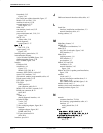
COMSPHERE 3000 Series Carrier
Glossary-4 December 1994 3000-A2-GA31-80
Make Busy An additional capability for DDD NIMs. This feature is useful when modems are
used in a ‘‘hunt” or ‘‘rotary” group. The Make Busy feature ties the Tip and Ring
signals together so that the modem appears busy. This feature is not used by DSUs
with DBMs, but using a NIM with this feature will not affect the DBM’s
performance. However, if a NIM is used with this feature, it must be used behind a
PBX.
Mode Indicate and Mode
Indicate Common
(MI/MIC) control
A control signal method which causes the associated modem to go off-hook in the
Originate mode. With MI/MIC signaling, two leads are provided, usually via Pins 3
and 6 of an 8-position modular VF connector: Mode Indicate and Mode Indicate
Common. Actuation of the signal is by momentary connection of these two leads.
modular circuit card A DSU or dial/lease modem that contains ‘‘gold finger” contacts on the rear edge of
the circuit card. A modular circuit card can be removed from the front of the carrier
without disturbing DTE cables.
Multichannel Multipoint
(MCMP)
A circuit card that enables the support of up to six independent applications over a
single multipoint digital facility. The MCMP capability can support up to
40 tributary DSUs, each optioned with an MCMP card.
network address The customer-assigned diagnostic address of a tributary DSU or modem.
Network Controller An AT&T NMS that uses the DATAPHONE II protocol.
Network Interface Module
(NIM)
The interface provided, up to two per carrier, for the public switched telephone
network (PSTN) used by V.32 dial backup modules (DBMs) and dial/lease
modems, and for the switched 56 kbps digital service used by the 2-wire and 4-wire
Switched 56 DBMs.
Network Management System
(NMS)
A set of diagnostic and configuration management tools for a data communication
network, consisting of software programs and dedicated computer hardware.
non-modular circuit card A carrier-mounted circuit card with connectors mounted onto the card. This circuit
card type requires that the DTE cables be disconnected before the circuit card is
removed from the carrier.
permissive interface A dial modem operating mode characterized by a fixed output power level of
–9 dBm. It is one of two possible modes of operation for DSUs or modems
connected to dial lines (see programmable interface).
physical address The diagnostic address of a control DSU or modem derived from its location in the
carrier: its carrier and slot number.
primary core This is the circuit card that is normally running when power is supplied to the unit.
In the case of a DBM-V, DBM-S, or DBM-D, the primary core and the active core
are the same.
programmable interface A dial modem operating mode characterized by an output power level (–12 to
0 dBm) set by a programming resistor in the datajack. It is one of two possible
modes of operation for DSUs or modems connected to dial lines (see permissive
interface).
PSTN Public Switched Telephone Network (dial network).


















